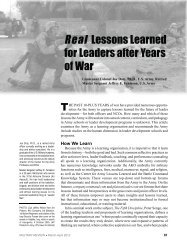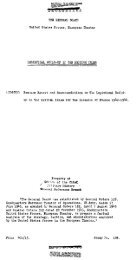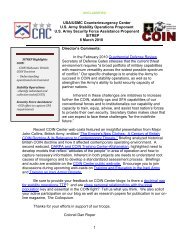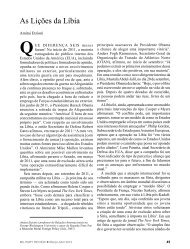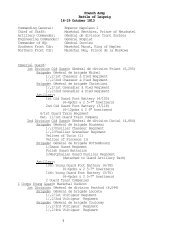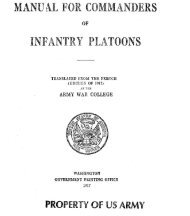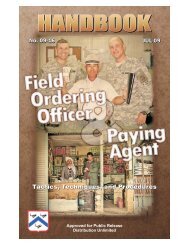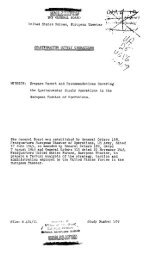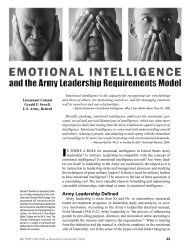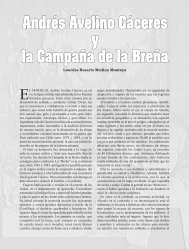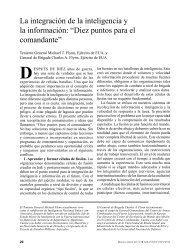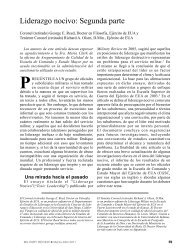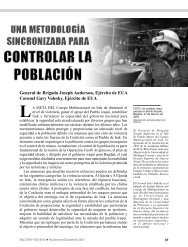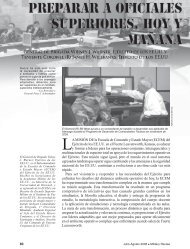Armor Magazine Counterinsurgency Selected Works - US Army
Armor Magazine Counterinsurgency Selected Works - US Army
Armor Magazine Counterinsurgency Selected Works - US Army
You also want an ePaper? Increase the reach of your titles
YUMPU automatically turns print PDFs into web optimized ePapers that Google loves.
specific targets, and time on station. Snipers were very effective<br />
in destroying RPG gunners along the walls of the mosque or in<br />
the minarets.<br />
Use every combat system available. During the Dukes’ fiveweek<br />
fight in Najaf/Kufa, the task force employed AC-130 gunships,<br />
Kiowa Warriors with Hellfire missiles, and Copperhead,<br />
as well as variable time (VT) and time fuse delayed (TFD) 155mm<br />
and 120mm. Each had a specific purpose built into the plan.<br />
AC-130 fires were deadly for clearing bunkers, destroying RPG<br />
gunners in the palm groves, and in canalizing the enemy. After<br />
the first few engagements, the enemy decided it was not wise to<br />
stay outside while the sound of the AC-130 circled overhead. We<br />
used this advantage in either driving the enemy back inside to<br />
allow us closer maneuver, or keeping him off station while an<br />
unmanned aerial vehicle (UAV) located a strongpoint, passed<br />
grid location, then called in the AC-130 to destroy his strongpoint.<br />
The Kiowa Warrior has a fantastic weapons platform. When resourced<br />
with Hellfire, a commander can engage those hard-toreach<br />
targets. Additionally, an armed UAV becomes the weapon<br />
of choice when engaging an enemy moving around urban terrain.<br />
During one of the task force’s last battles, an enemy mortar<br />
man, using a pickup truck with a 82mm mortar in the back,<br />
was conducting attacks on FOB Golf. The UAV was brought in;<br />
it identified, followed, and when conditions were right, destroyed<br />
the mortar, mortar man, and truck, with absolutely no collateral<br />
damage.<br />
Paladin fires were critical to our success. We fired all types of<br />
munitions. Later in the campaign, the enemy developed his own<br />
methods to counter traditional ‘fire for effect’ high explosive<br />
rounds. The enemy would remain inside buildings or along the<br />
roofs of sensitive targets. On occasion, we would engage enemy<br />
on rooftops or engage an enemy mortar man near a built-up area<br />
with VT. In one instance, there were enemy RPG gunners and<br />
riflemen across the river inside a second-story building preventing<br />
a troop from maneuvering into a support-by-fire (SBF) position.<br />
Six TFD rounds later, the troop established the SBF and<br />
the mission continued with the enemy destroyed.<br />
Early in the campaign we used Copperhead with OH-58D to<br />
destroy bunkers along narrow streets and in palm groves. The<br />
system works, with practice, and allows the maneuver commander<br />
freedom of movement along lateral routes. The task<br />
force also had an opportunity to employ an Iraqi counterterrorism<br />
force, which was impressive. The enemy believed the coalition<br />
would not enter mosques because their information operations<br />
campaign had convinced them of such. The enemy’s information<br />
was correct! The coalition did not enter the mosque<br />
— the Iraqi counterterrorism force did, destroying five enemy<br />
riflemen and locating and confiscating a cache of mortars, RPGs,<br />
AK47s, and hand grenades.<br />
The impact of nonlethal fires is integral to any campaign. The<br />
task force was well armed with a tactical psychological team<br />
(TPT), two civil affairs (CA) teams, two attack/bomb dog teams,<br />
PROPHET, engineers, and several media sources. For example,<br />
the task force would target neighborhoods identified by<br />
electronic warfare assets that indica ted local people were undecided<br />
on coalition sup port. We would move in and project a positive<br />
message with the TPT, followed by CA teams, who developed<br />
projects on the ground. We also sent in the TPT and CA<br />
teams during the ‘mitigation phase’ of operations to assess<br />
public sentiment and collect information on collateral damage.<br />
The bomb/attack dog teams were used on every operation involving<br />
suspected arms caches or mortar firing positions, and<br />
the engineers were critical in building force protection around<br />
FOBs, Iraqi police stations, and other highly sensitive targets.<br />
The task force also used the engineers to recover jersey barriers<br />
employed by the enemy along trench lines and to fill in enemy<br />
trench lines and fighting positions.<br />
The media should be treated like family because they target the<br />
international community and keep higher echelons of command<br />
happy. The information provided before and immediately following<br />
the operation determined how successful the story got<br />
out. Normally, the task force commander briefly described the<br />
operation, concept and target, and placed the reporters in a vehicle<br />
(M1114 or M113), which trailed one of the companies.<br />
After the fight, a quick recap of what happened, maybe an interview<br />
for clarification, and the story<br />
is done. In some instances, commanders<br />
need to ‘go live’ during a<br />
fight, to ensure the press does not<br />
make assumptions. In all cases, treating<br />
the press with dignity and respect<br />
paid huge dividends.<br />
“The most precise weapons system in<br />
the task force was the M1A1 main battle<br />
tank. The coaxial-mounted M240 machine<br />
gun is precision at its best. Outrange<br />
the enemy RPG gunner and you<br />
can conduct precision recon-by-fire in<br />
urban terrain while minimizing collateral<br />
damage. The tank also has the most<br />
accurate and deadly system available<br />
— the 120mm main gun. Tank commanders<br />
learned early on that firing a<br />
multipurpose antitank (MPAT) round, a<br />
high-explosive antitank (HEAT) round,<br />
or an obstacle-reducing (OR) round<br />
immediately silenced enemy massed<br />
formations due to tremendous psychological<br />
effects.”<br />
22 — September-October 2008



